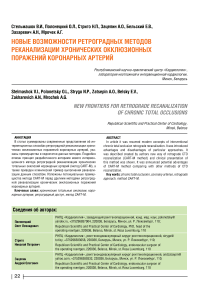Новые возможности ретроградных методов реканализации хронических окклюзионных поражений коронарных артерий
Автор: Стельмашок В.И., Полонецкий О.Л., Стриго Н.П., Зацепин А.О., Бельский Е.В., Захаревич А.Н., Мрочек А.Г.
Журнал: Евразийский кардиологический журнал @eurasian-cardiology-journal
Рубрика: Обзор
Статья в выпуске: 3, 2016 года.
Бесплатный доступ
В статье суммированы современные представления об интервенционных способах ретроградной реканализации хронических окклюзионных поражений коронарных артерий, указаны преимущества и недостатки данных методов. Подробно описан принцип разработанного авторами нового интервенционного метода ретроградной реканализации хронических тотальных окклюзий коронарных артерий (метод CART-M), а также приведен клинический пример выполнения реканали-зации данным способом. Изложены потенциальные преимущества метода CART-M перед другими методами ретроградной реканализации хронических окклюзионных поражений коронарных артерий.
Хронические тотальные окклюзии, коронарные артерии, ретроградный доступ, метод cart-m
Короткий адрес: https://sciup.org/14343382
IDR: 14343382
Список литературы Новые возможности ретроградных методов реканализации хронических окклюзионных поражений коронарных артерий
- Stone G.W., Reifart N.J., Moussa I. et al. Percutaneous recanalization of chronically occluded coronary arteries: a consensus document: part I. Circulation. 2005. Vol. 112, N 15. P. 2364-2372.
- DiMario C., Werner G.S., Sianos G. et al. European perspective in the recanalization of Chronic Total Occlusions (CTO): consensus document from the EuroCTO Club. Eurolntervention. 2007. Vol. 3, N 1. P. 30-43.
- Galassi A.R., Tomasello S.D., Reifart N. et al. In-hospital outcomes of percutaneous coronary intervention in patients with chronic total occlusion: insights from the ERCTO (European Registry of Chronic Total Occlusion) registry. Eurolntervention. 2011. Vol. 7, N 4. P. 472-479.
- Morino Y., Kimura T., Hayashi T. et al. J-CTO registry investigators. In-hospital outcomes of contemporary percutaneous coronary intervention in patients with chronic total occlusion. JACC Cardiovasc. Interv. 2009. Vol. 3, N 2. P. 143-51.
- Thompson C.A., Jayne J.E., Robb J.F. et al. Retrograde techniques and the impact of operator volume on percutaneous intervention for coronary chronic total occlusions. JACC Cardiovasc. Interv. 2009. Vol. 2, N 9. P. 834-842.
- Sianos G., Konstantinidis N. V., Di Mario C. et al. Theory and practical based approach to chronic total occlusions. BMC Cardiovascular Disorders. 2016; 16: 33. Published online 2016 Feb 9 DOI: 10.1186/s12872-016-0209-3
- Srivatsa S.S., Edwards W.D., Boos C.M. et al. Histologic correlates of angiographic chronic total coronary artery occlusions: influence of occlusion duration on neovascular channel patterns and intimal plaque composition. J. Am. Coll. Cardiol. 1997. Vol. 29, N 5. P. 955-963.
- Katsuragawa M., Fujiwara H., Miyamae M. et al. Histologic studies in percutaneous transluminal coronary angioplasty for chronic total occlusion: comparison of tapering and abrupt types of occlusion and short and long occluded segments. J. Am. Coll. Cardiol. 1993. Vol. 21, N 3. P. 604611.
- Srivatsa S., Holmes D. The Histopathology of angiographic chronic total coronary artery occlusions and changes in neovascular pattern and intimal plaque composition associated with progressive occlusion duration. J. Invasive Cardiol. 1997. Vol. 9, N 4. P. 294-301.
- Waksman R., Saito S. Chronic total occlusions: a guide to recanalization. Ed. by Waksman R., Saito S.: Blackwell Publishing Ltd., 2009,198 P.
- Surmely J.F., Tsuchikane E., Katoh O. et al. New concept for CTO recanalisation using controlled antegrade and retrograde subintimal tracking: the CART technique. J. Invas. Cardiol. 2006. Vol. 18, N 7. P. 334-338.
- Saito S. Different strategies of retrograde approach in coronary angioplasty for chronic total occlusion. Catheter Cardiovasc. Interv. 2008. Vol. 71, N 1. P. 8-19.
- Sianos G., Barlis P., Di Mario C. et al. European experience with the retrograde approach for the recanalisation of coronary artery chronic total occlusions. A report on behalf of the EuroCTO club. EuroIntervention. 2008. Vol. 4, N1. P. 84-92.
- Kimura M., Katoh O., Tsuchikane E. The efficacy of a bilateral approach for treating lesions with chronic total occlusions. JACC Cardiovasc. Interv. 2009. Vol. 2, N11. P. 1135-1141.
- Cohen M., Rentrop K.P. Limitation of myocardial ischemia by collateral Circulation during sudden controlled coronary artery occlusion in human subject: a prospective study. Circulation. 1986. Vol. 74, N 3. P. 469-476.
- Werner G.S., Ferrari M., Heinke S. et al. Angiographic assessment of collateral connections in comparison with invasively determined collateral function in chronic coronary occlusions. Circulation. 2003. Vol. 107, N 15. P. 1972-1977.
- Tsuchikane E., Katoh O., Kimura M. et al. The first clinical experience with a novel catheter for collateral channel tracking in retrograde approach for chronic coronary total occlusions. JACC Cardiovasc. Interv. 2010. Vol. 3, N 2. P. 165-171.
- Bufe A., Haltern G., Dinh W. et al. Recanalisation of coronary chronic total occlusions with new techniques including the retrograde approach via collaterals. Neth. Heart J. 2011. Vol. 19, N 4. P. 162-167.
- Michael T.T., Papayannis A., Banerjee S. et al. Subintimal Dissection/Re-entry Strategies in Coronary Chronic Total Occlusion Interventions. Circ. Cardiovasc. Interv. 2012. Vol. 5, N 5. P. 729-738.
- Rathore S., Katoh O., Tuschikane E. et al. A novel modification of the retrograde approach for the recanalization of chronic total occlusion of the coronary arteries intravascuar ultrasound-guided reverse controlled antegrade and retrograde tracking. JACC Cardiovasc. Interv. 2010. Vol. 3, N 2. P. 155-164.
- Nijjer S., Di Mario C. Reverse STAR for retrograde recanalisation in a chronic total coronary artery occlusion present for 21 years. BMJ Case Reports 2010; doi:10.1136/bcr.05.2009.1903


